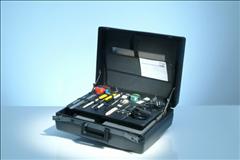 Boost your strain gauge installation know-how now!
Boost your strain gauge installation know-how now!
October 22, 2014 REDWIRE is news you can use from leading suppliers. Powered by FRASERS.
Posted by Durham Instruments
One Source For All Your Quantitative Measuring Needs. With Over 50 Yrs.Of Experience In The Instrumentation Field. It Of... Read more
Subscribe
Free REDWIRE e-newsletter

Now that you know what a strain gauge amplifier is from reading our last article, let’s take a step back to show you the importance of strain gauge installation.
Strain gauges and their installation form a unit, which means that one is critically dependent on the other one’s success.
Because a strain gauge performs best when the strain to be measured is transferred faultlessly and free of loss, the connection between the strain gauge and object of measurement must be a solid one with the appropriate application of special adhesives.
While bonding consistently plays a prominent role, various conditions and influences require different bonding agents and installation methods. A general principle to remember is adhesion is primarily based on adhesion forces between neighbouring molecules. Thus, the connection of bonded parts relies on the adhesion between the cement and the surface of the specimen.
But, before you head out to load up your shopping cart with various types of strain gauge bonding agents, become an agent yourself by taking stock on proper installation preparations to ensure optimal strain gauge measurement and high quality adhesion performance.
Planning, material and enlistment of skilled installation personnel, such as engineers and strain gauge technicians, are the vitally important conditions needed prior to strain gauge installation.
Ask yourself the 5Ws + H when strain gauge installation planning. (We will assume you already know WHY you are measuring strain for your unique application).
- What quantity of strain will be measured?
- Where will the measurement take place, for example, indoors or outdoors?
- When will preparation, installation, trials, measurement or evaluation take place?
- Who will be the qualified personnel responsible to install the strain gauge?
- How will the strain gauge be used and how will it perform under other conditions, such as static measuring or dynamic measuring?
Armed and ready to go? Look forward to our next article that will give you a 90 second rundown on strain gauge adhesive basics. Until then, visit our comprehensive virtual catalogue for your all your measurement and sensor business needs.
Share
Posted by Durham Instruments
One Source For All Your Quantitative Measuring Needs. With Over 50 Yrs.Of Experience In The Instrumentation Field. It Of... Read more
